Written by DJL Agriculture
It was 2010 when Nigel Roobottom and David Lievesley began to see that things needed to go down a more diverse route at Highlands Park Farm, Rangemore, nr Burton-on-Trent in Staffordshire.
Nigel and Fiona Roobottom secured the tenancy of the farm, previously farmed in hand by Lord Burton, Rangemore Estates in 2003, the 450 Acre farm, which was home to The Baileys Herd and is currently home to Nigel & Fiona’s 180 cow herd of Holstein Friesians. As of many Estate Farms, through the years of intensity the soil was very much taken for granted with two dairy herds and an Arable Unit, the fertilizer bag was very much at the forefront of the soil plan. With an abundance of slurry, which in those years was a waste disposal task there was a huge biological imbalance in the making!
When the Estate was tenanted out and Nigel Roobottom began farming the farm in his own rights problems started to appear in the cows. Nigel, a very passionate grazer of cows wanted a system that would lend itself to a relative, no nonsense management strategy. With an all year-round calving pattern back then, metabolic problems appeared at calving, leading to the cows not being able to get up.
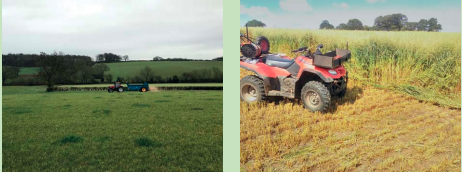
Nigel, working together with Dave Leivesley began thinking out of the box with Dave Leivesley’s philosophy of you can’t fix a cow in three weeks, that meaning many people think that three weeks before calving is the Holy Grail. Whilst being important it’s also critical to manage the calcium element of the farm and the cows throughout the lactation. We began to recognise the lack of worms, with the slurry being spread with an umbilical cord splash plate. The decision was taken in April 2007 to invest in a Dribble Bar Slurry Tanker to give more flexibility to the system and to be able to apply slurry at optimum application rates.
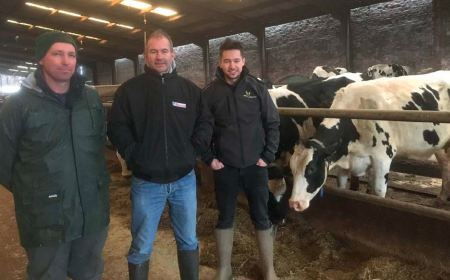
Dave Leivesley who has worked with Nigel for many years and focuses heavily on the synergy of soil sample results to health of the cow, wanted to look also at aeration as oxygen is a vital component of soil health. The slurry lagoon was already treated with Bacillus based slurry additive, designed to create a homogenous Aerobic manure. Which in Dave and Nigel’s terms was like feeding the land Bio-yoghurt. To back this up it was then decided to invest in a slot aerator in partnership with a neighbour to help get more air flowing through the heavy soils.
With Calcium very much in the mindset, the fertiliser aspect was then looked at and we turned our attention to C.A.N (Calcium Ammonium Nitrate) with Dave’s knowledge indicating that 1kg of N displaces 3.5kg of Ca, so we need to keep topping up that calcium for the health of our stock. It is my belief that when the Ph of our land drops below 6.4 we leave ourselves open to disease, and with the modern cow becoming a “pin cushion” for the vaccination needle we believe our land should be pro-biotic supporting the healthy bacteria which build up in our immune system.
The journey of biological farming began to gain pace with Nigel and Dave already seeing cow health in a better place, milk quality on a rising level with butterfat and protein increasing, Somatic cell count lowering and body condition in a healthy score. With a mixed farming approach, the forage make-up of the feeding plan is made up of grass silage mixed with arable silage, that being of an Oats and peas mixture and barley being grown in the rotation. Also, oats are used heavily in the plan, with their phosphorus scavenging property and peas, a legume fixing organic N into the soil. The crop protection piece of the biological jigsaw is the job of Daniel Leivesley, Dave’s son, who is a Biological Agronomist. Turning his attention to Bio-Stimulants and Carbon-Based foliar feeds and away from the chemical story!
The crops are drilled using a SimtechAitcheson T-Slot Drill, with the plough being sold a number of years ago! The Simtech has proved a great asset to the farm, with the T-Slot allowing air around the seed aiding germination. A front tank is currently being constructed on farm, giving the option to feed the seed with Bacillus Bacteria when it is placed in the soil. That in mind the attention turns to plant diversity within the grazing leys, with the focus on root zones, Dave creates his own ‘Grazing recipe’ with alternative thinking and herbal mixtures featuring heavily in the system. Species such as Chicory, Rantain, Clover mixes and Traditional Grasses such as timothy are included alongside Diploid and Tetraploid Ryegrasses. It is important that we have root zones at varying depths to both create aeration and mineralisation, the important part of Carbon Sequestation is for the soil to have a canopy, thus creating better photosynthesis and reducing Carbon Loss.
With few words passing by without the word ‘Calcium’ appearing again, Gypsum is very much on the shopping list at Highlands Park. To aid these high magnesium index soils, Organic Gypsum is spread in a rotation at 1 Tonne to the acre using the farms Bunning Rear Discharge Spreader. This can be seen on Dave Leivesley’s website, www.djlagriculture.co.uk, the focus being as a soil conditioner , but only mined organic Gypsum is used as a strict measure.
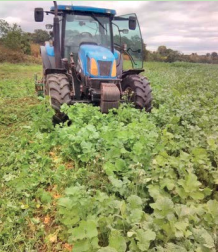
The concentrate element of the cow ration is also a key feature in what we call the Bio System, with Dave saying, feeding the soil is like feeding the cow and the importance of Amino Acids. This makes up the Bio-Circle says Dave, with ingredients such as Prairie Meal, Sugar Beet Pulp and other healthy components. My thinking is that if we focus on By-products so readily available to us the soil is the end user and that’s not necessarily healthy. If we focus on quality amino Acids the soil benefits via the manure. Back to the slurry tanker, where the dots are joined again the Dribble Bar System allows slurry, which by appearance and smell is a ‘Health Option’ and is placed in the sward when the timing is right, and conditions allow.
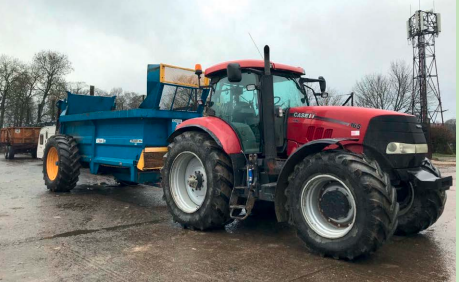
The fertilizer has been significantly reduced with F.Y.M and slurry being an asset to the farm. The F.Y.M is also taken very seriously with yards being cleaned out, the manure is stacked and turned in the same way as compost, with organic matter being high on the list. You can actually see the healthy fungi within the manure, this is only contributing to the healthy mychorisal present in the soils. Today’s heavy focus on reducing antibiotic usage is a very important goal. It is clear that our cows and youngstock are of a high health status, with the system having been implemented a number of years ago. It is also clear that this is the route to sustainable farming and food production.
Recently humates were brought into the story, with Leonodite being added to the dairy and youngstock ration and as an experiment Humic Acid was added to the biological silage additive and applied to the whole crop oats and peas. With Humates forming part of the antiviral chain and consequently finishing up in the soil. It is the way forward in creating total natural immune defence mechanisms. Coming from the early years of taking on the tenancy when the cropping, as of many farms, was wheat, maize silage and grass silage. Where grass remains the wheat and maize have been replaced with the more sustainable crops mentioned earlier.
Due to the change in cropping and farming system, the livestock can enjoy a calmer, stress free lifestyle. Being able to change the calving pattern to capitalize on the milk contract has brought about times where the system is less demanding on labour, thus giving a better lifestyle all round. The ability to add cover cropping into the system has allowed the drill to furthermore add to its benefits, whilst creating plants that pump minerals at every opportunity. With the herds grazing heavily for many months of the year it is obvious that the potash indexes have to be taken seriously. One problem that came up a number of years ago was the selective grazing by the cows. This needed some ‘out of the box thinking’. The sodium element was being supressed by the extensive K index and again needed to be taken seriously.
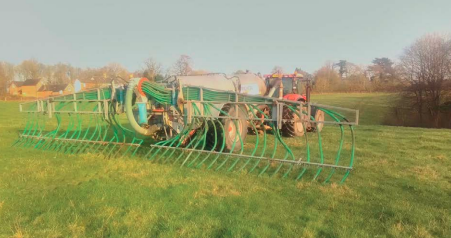
It was decided that a Carbon-based molasses foliar feed was applied through the sprayer, with the soil being a living medium we needed to ‘feed the bugs’ just like you feed a cow’s rumen. The sugars being systemically taken through the foliage and into the soil system had marked effects on grazing palatability making the sodium element more readily exchanged. This is protocol that will continue as part of the management plan. Currently the farm is achieving a yield from home grown energy. With a young herd, 30% being in their first lactation, and an 8500 litre lactation calving interval of 388 days and a yield from home grown forage, around 4000 litres, it is fair to say that the mixture of regenerative farming and dairy cows go hand in hand.
In summary and ten years down the line, the land and cows are in a great place. Challenges do crop up as they do in farming, but it is fair to say that with managing biology, problem solving is way down being replaced with positive thinking.